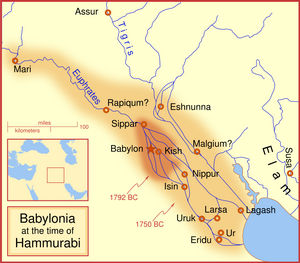Nippur
| Author:Laxman Burdak, IFS (R) |

Nippur was an ancient Sumerian city. Nippur was located in modern Nuffar in Afak, Al-Qādisiyyah Governorate, Iraq. It was the special seat of the worship of the Sumerian god Enlil, the "Lord Wind", ruler of the cosmos, subject to An alone.
Variants
- Sumerian: Nibru, often logographically recorded as 𒂗𒆤𒆠, EN.LÍLKI, "Enlil City;"[1]
- Akkadian: Nibbur
- Modern Nuffar in Afak
Location
Nippur was located in modern Nuffar in Afak, Al-Qādisiyyah Governorate, Iraq. It is roughly 200 kilometers south of modern Baghdad and about 60 miles southeast of the ancient city of Babylon. Occupation at the site extended back to the Ubaid period (Ubaid 2 - Hajji Muhammed), the Uruk period, and the Jemdet Nasr period. The origin of the ancient name is unknown but different proposals have been made.[2]
History
Nippur never enjoyed political hegemony in its own right, but its control was crucial, as it was considered capable of conferring the overall "kingship" on monarchs from other city-states. It was distinctively a sacred city, important from the possession of the famous Ekur temple of Enlil. Ninurta, son of Enlil, also had his main cult center, the E-shumesha temple, in the city-state.[3][4]
According to the Tummal Chronicle, Enmebaragesi, an early ruler of Kish, was the first to build up this temple.[5] His influence over Nippur has also been detected archaeologically. The Chronicle lists successive early Sumerian rulers who kept up intermittent ceremonies at the temple: Aga of Kish, son of Enmebaragesi; Mesannepada of Ur; his son Meskiang-nunna; Gilgamesh of Uruk; his son Ur-Nungal; Nanni of Ur and his son Meskiang-nanna. It also indicates that the practice was revived in the Ur III period by Ur-Nammu of Ur, and continued until Ibbi-Sin appointed Enmegalana high priest in Uruk (c. 1950 BC).
Inscriptions of Lugal-Zage-Si and Lugal-kigub-nidudu, kings of Uruk and Ur respectively, and of other early rulers, on door-sockets and stone vases, show the veneration in which the ancient shrine was then held, and the importance attached to its possession, as giving a certain stamp of legitimacy. On their votive offerings, some of these rulers designate themselves as ensis, or governors.
In Jat History
References
- ↑ I. E. S. Edwards, C. J. Gadd, N. G. L. Hammond, "The Cambridge Ancient History: Prolegomena & Prehistory: Vol. 1, Part 1, Cambridge University Press, 1970 ISBN 9780521070515
- ↑ Jacobsen, T., "The Assumed Conflict between Sumerians and Semites in Early Mesopotamian History", Journal of the American Oriental Society 59/4, pp. 485–495, 1939
- ↑ Robson, Eleanor (2015), "Ninurta, god of victory", Nimrud: Materialities of Assyrian Knowledge Production, Open Richly Annotated Cuneiform Corpus, UK Higher Education Academy
- ↑ Black, Jeremy; Green, Anthony (1992), Gods, Demons and Symbols of Ancient Mesopotamia: An Illustrated Dictionary, Austin, Texas: University of Texas Press, p. 142, ISBN 0714117056
- ↑ Jean-Jacques Glassner, Mesopotamian Chronicles, Brill Academic, 2005, ISBN 90-04-13084-5
Back to Jat Places in Iranq

